Effect of Chronic Tibolone Administration on Memory and Choline Acetyltransferase and Tryptophan Hydroxylase Content in Aging Mice
Abstract
:1. Introduction
2. Materials and Methods
2.1. Animals
2.2. Treatments
2.3. Memory Evaluation
2.3.1. Object Recognition Task
2.3.2. Object-in-Context Recognition Task
2.3.3. Elevated T-Maze
2.4. Spontaneous Activity Test
2.5. Protein Extraction and Western Blotting
2.6. Statistical Analysis
3. Results
3.1. Effect of Aging on Cognitive Ability
3.2. Effect of Long-Term TIB Treatment on Cognitive Ability in Aging Mice
3.3. ChAT and TPH Content in the Hippocampus of Aging Mice
4. Discussion
5. Conclusions
Supplementary Materials
Author Contributions
Funding
Institutional Review Board Statement
Informed Consent Statement
Data Availability Statement
Acknowledgments
Conflicts of Interest
References
- Gao, S.; Hendrie, H.C.; Hall, K.S.; Hui, S. The Relationships between Age, Sex, and the Incidence of Dementia and Alzheimer Disease. Arch. Gen. Psychiatry 1998, 55, 809–815. [Google Scholar] [CrossRef] [PubMed]
- Henderson, V.W. Estrogen, Cognition, and a Woman’s Risk of Alzheimer’s Disease. Am. J. Med. 1997, 103, 11S–18S. [Google Scholar] [CrossRef] [PubMed]
- Mulnard, R.A.; Cotman, C.W.; Kawas, C.; van Dyck, C.H.; Sano, M.; Doody, R.; Koss, E.; Pfeiffer, E.; Jin, S.; Gamst, A.; et al. Estrogen Replacement Therapy for Treatment of Mild to Moderate Alzheimer Disease. JAMA 2000, 283, 1007–1015. [Google Scholar] [CrossRef] [PubMed]
- Paganini-Hill, A.; Henderson, V.W. Estrogen Deficiency and Risk of Alzheimer’s Disease in Women. Am. J. Epidemiol. 1994, 140, 256–261. [Google Scholar] [CrossRef]
- Sherwin, B.B. Estrogen and cognitive aging in women. Neuroscience 2006, 138, 1021–1026. [Google Scholar] [CrossRef]
- Duff, S.J.; Hampson, E. A Beneficial Effect of Estrogen on Working Memory in Postmenopausal Women Taking Hormone Replacement Therapy. Horm. Behav. 2000, 38, 262–276. [Google Scholar] [CrossRef]
- Duka, T.; Tasker, R.; McGowan, J.F. The effects of 3-week estrogen hormone replacement on cognition in elderly healthy females. Psychopharmacology 2000, 149, 129–139. [Google Scholar] [CrossRef]
- Resnick, S.M.; Maki, P.M.; Golski, S.; Kraut, M.A.; Zonderman, A.B. Effects of Estrogen Replacement Therapy on PET Cerebral Blood Flow and Neuropsychological Performance. Horm. Behav. 1998, 34, 171–182. [Google Scholar] [CrossRef]
- Hogervorst, E.; Boshuisen, M.; Riedel, W.; Willeken, C.; Jolles, J. The effect of hormone replacement therapy on cognitive function in elderly women. Psychoneuroendocrinology 1999, 24, 43–68. [Google Scholar] [CrossRef]
- Kang, J.H.; Weuve, J.; Grodstein, F. Postmenopausal hormone therapy and risk of cognitive decline in community-dwelling aging women. Neurology 2004, 63, 101–107. [Google Scholar] [CrossRef]
- Isaev, N.K.; Stelmashook, E.V.; Genrikhs, E.E. Neurogenesis and brain aging. Rev. Neurosci. 2019, 30, 573–580. [Google Scholar] [CrossRef]
- Haam, J.; Yakel, J.L. Cholinergic modulation of the hippocampal region and memory function. J. Neurochem. 2017, 142, 111–121. [Google Scholar] [CrossRef]
- Ott, T.; Nieder, A. Dopamine and Cognitive Control in Prefrontal Cortex. Trends Cogn. Sci. 2019, 23, 213–234. [Google Scholar] [CrossRef] [PubMed]
- Buhot, M.-C.; Martin, S.; Segu, L. Role of serotonin in memory impairment. Ann. Med. 2000, 32, 210–221. [Google Scholar] [CrossRef] [PubMed]
- Juan, S.M.A.; Adlard, P.A. Ageing and Cognition. In Biochemistry and Cell Biology of Ageing: Part II Clinical Science. Subcellular Biochemistry; Springer: Singapore, 2019; pp. 107–122. [Google Scholar] [CrossRef]
- Maggio, M.; Dall’Aglio, E.; Lauretani, F.; Cattabiani, C.; Ceresini, G.; Caffarra, P.; Valenti, G.; Volpi, R.; Vignali, A.; Schiavi, G.; et al. The hormonal pathway to cognitive impairment in older men. J. Nutr. Health Aging 2012, 16, 40–54. [Google Scholar] [CrossRef]
- Cai, Z.; Li, H. An Updated Review: Androgens and Cognitive Impairment in Older Men. Front. Endocrinol. 2020, 11, 586909. [Google Scholar] [CrossRef] [PubMed]
- McEwen, B.S. The Molecular and Neuroanatomical Basis for Estrogen Effects in the Central Nervous System. J. Clin. Endocrinol. Metab. 1999, 84, 1790–1797. [Google Scholar] [CrossRef]
- Foster, T.C.; Sharrow, K.M.; Kumar, A.; Masse, J. Interaction of age and chronic estradiol replacement on memory and markers of brain aging. Neurobiol. Aging 2003, 24, 839–852. [Google Scholar] [CrossRef]
- Gibbs, R.B. Effects of gonadal hormone replacement on measures of basal forebrain cholinergic function. Neuroscience 2000, 101, 931–938. [Google Scholar] [CrossRef]
- Markham, J.A.; Pych, J.C.; Juraska, J.M. Ovarian Hormone Replacement to Aged Ovariectomized Female Rats Benefits Acquisition of the Morris Water Maze. Horm. Behav. 2002, 42, 284–293. [Google Scholar] [CrossRef]
- Frick, K.M.; Fernandez, S.M.; Bulinski, S.C. Estrogen replacement improves spatial reference memory and increases hippocampal synaptophysin in aged female mice. Neuroscience 2002, 115, 547–558. [Google Scholar] [CrossRef]
- Miller, M.M.; Hyder, S.M.; Assayag, R.; Panarella, S.R.; Tousignant, P.; Franklin, K.B.J. Estrogen modulates spontaneous alternation and the cholinergic phenotype in the basal forebrain. Neuroscience 1999, 91, 1143–1153. [Google Scholar] [CrossRef] [PubMed]
- Vaucher, E.; Reymond, I.; Najaffe, R.; Kar, S.; Quirion, R.; Miller, M.M.; Franklin, K.B. Estrogen effects on object memory and cholinergic receptors in young and old female mice. Neurobiol. Aging 2002, 23, 87–95. [Google Scholar] [CrossRef] [PubMed]
- Frick, K.M.; Burlingame, L.A.; Delaney, S.S.; Berger-Sweeney, J. Sex differences in neurochemical markers that correlate with behavior in aging mice. Neurobiol. Aging 2002, 23, 145–158. [Google Scholar] [CrossRef] [PubMed]
- Joseph, J.A.; Berger, R.E.; Engel, B.T.; Roth, G.S. Age-related Changes in the Nigrostriatum: A Behavioral and Biochemical Analysis. J. Gerontol. 1978, 33, 643–649. [Google Scholar] [CrossRef] [PubMed]
- MacLusky, N.J.; Clark, C.R.; Shanabrough, M.; Naftolin, F. Metabolism and binding of androgens in the spinal cord of the rat. Brain Res. 1987, 422, 83–91. [Google Scholar] [CrossRef]
- Janowsky, J.S.; Oviatt, S.K.; Orwoll, E.S. Testosterone influences spatial cognition in older men. Behav. Neurosci. 1994, 108, 325–332. [Google Scholar] [CrossRef]
- Daniel, J.M.; Dohanich, G.P. Acetylcholine Mediates the Estrogen-Induced Increase in NMDA Receptor Binding in CA1 of the Hippocampus and the Associated Improvement in Working Memory. J. Neurosci. 2001, 21, 6949–6956. [Google Scholar] [CrossRef]
- Gibbs, R.B. Estrogen Replacement Enhances Acquisition of a Spatial Memory Task and Reduces Deficits Associated with Hippocampal Muscarinic Receptor Inhibition. Horm. Behav. 1999, 36, 222–233. [Google Scholar] [CrossRef]
- Bassil, N.; Alkaade, S.; Morley, J.E. The benefits and risks of testosterone replacement therapy: A review. Ther. Clin. Risk Manag. 2009, 5, 427–448. [Google Scholar] [CrossRef]
- Tan, S.; Porter, T.; Bucks, R.S.; Weinborn, M.; Milicic, L.; Brown, A.; Rainey-Smith, S.R.; Taddei, K.; Ames, D.; Masters, C.L.; et al. Androgen receptor CAG repeat length as a moderator of the relationship between free testosterone levels and cognition. Horm. Behav. 2021, 131, 104966. [Google Scholar] [CrossRef] [PubMed]
- Bimonte-Nelson, H.A.; Singleton, R.S.; Nelson, M.E.; Eckman, C.B.; Barber, J.; Scott, T.Y.; Granholm, A.C. Testosterone, but not nonaromatizable dihydrotestosterone, improves working memory and alters nerve growth factor levels in aged male rats. Exp. Neurol. 2003, 181, 301–312. [Google Scholar] [CrossRef] [PubMed]
- Pike, C.J. Sex and the development of Alzheimer’s disease. J. Neurosci. Res. 2017, 95, 671–680. [Google Scholar] [CrossRef] [PubMed]
- Conner, P.; Christow, A.; Kersemaekers, W.; Söderqvist, G.; Skoog, L.; Carlström, K.; Tani, E.; Mol-Arts, M.; von Schoultz, B. A comparative study of breast cell proliferation during hormone replacement therapy: Effects of tibolone and continuous combined estrogen–progestogen treatment. Climacteric 2004, 7, 50–58. [Google Scholar] [CrossRef]
- Kenemans, P. Postmenopausal hormone therapy and breast cancer: What is the problem? Maturitas 2005, 51, 75–82. [Google Scholar] [CrossRef]
- Reed, M.J.; Kloosterboer, H.J. Tibolone: A selective tissue estrogenic activity regulator (STEAR). Maturitas 2004, 48, 4–6. [Google Scholar] [CrossRef]
- Campisi, R.; Marengo, F.D. Cardiovascular Effects of Tibolone: A Selective Tissue Estrogenic Activity Regulator. Cardiovasc. Drug Rev. 2007, 25, 132–145. [Google Scholar] [CrossRef]
- Verheul, H.A.M.; Timmer, C.J.; Kloosterboer, H.J. Pharmacokinetic parameters of sulfated tibolone metabolites in postmenopausal women after single and multiple doses of tibolone. Clin. Pharmacol. Ther. 2007, 81, 573–579. [Google Scholar] [CrossRef]
- Verheul, H.A.M.; Van Iersel, M.L.P.S.; Delbressine, L.P.C.; Kloosterboer, H.J. Selective tissue distribution of tibolone metabolites in mature ovariectomized female cynomolgus monkeys after multiple doses of tibolone. Drug Metab. Dispos. 2007, 35, 1105–1111. [Google Scholar] [CrossRef]
- Palomba, S.; Orio, F.; Falbo, A.; Oppedisano, R.; Tolino, A.; Zullo, F. Tibolone reverses the cognitive effects caused by leuprolide acetate administration, improving mood and quality of life in patients with symptomatic uterine leiomyomas. Fertil. Steril. 2008, 90, 165–173. [Google Scholar] [CrossRef]
- Qiu, J.; Bosch, M.A.; Rønnekleiv, O.K.; Kloosterboer, H.J.; Kelly, M.J. Tibolone rapidly attenuates the GABAB response in hypothalamic neurones. J. Neuroendocr. 2008, 20, 1310–1318. [Google Scholar] [CrossRef] [PubMed]
- Aguiar, R.B.; Dickel, O.E.; Cunha, R.W.; Monserrat, J.M.; Barros, D.M.; Martinez, P.E. Estradiol valerate and tibolone: Effects upon brain oxidative stress and blood biochemistry during aging in female rats. Biogerontology 2008, 9, 285–298. [Google Scholar] [CrossRef] [PubMed]
- de Aguiar, R.B.; Dickel, O.E.; Cunha, R.W.; Monserrat, J.M.; Barros, D.M.; Martinez, P.E. Estradiol valerate and tibolone: Effects on memory. Pharmacol. Biochem. Behav. 2006, 85, 689–696. [Google Scholar] [CrossRef] [PubMed]
- Ceylan, U.; Akhan, S.E.; Bastu, E.; Gungor-Ugurlucan, F.; Iyibozkurt, A.C.; Topuz, S. Comparison of tibolone and 17beta-estradiol administration on the expression of zonula occludens-1, occludin, glial fibrillary acidic protein and c-fos levels in the brain cortex and hippocampus of female rats. Neuro Endocrinol. Lett. 2012, 33, 505–510. [Google Scholar]
- Pinto-Almazán, R.; Calzada-Mendoza, C.C.; Campos-Lara, M.G.; Guerra-Araiza, C. Effect of chronic administration of estradiol, progesterone, and tibolone on the expression and phosphorylation of glycogen synthase kinase-3β and the microtubule-associated protein tau in the hippocampus and cerebellum of female rat. J. Neurosci. Res. 2012, 90, 878–886. [Google Scholar] [CrossRef]
- Espinosa-Raya, J.; Plata-Cruz, N.; Neri-Gómez, T.; Camacho-Arroyo, I.; Picazo, O. Effects of short-term hormonal replacement on learning and on basal forebrain ChAT and TrkA content in ovariectomized rats. Brain Res. 2011, 1375, 77–84. [Google Scholar] [CrossRef]
- Neri-Gómez, T.; Espinosa-Raya, J.; Díaz-Cintra, S.; Segura-Uribe, J.; Orozco-Suárez, S.; Gallardo, J.M.; Guerra-Araiza, C. Tibolone modulates neuronal plasticity through regulating Tau, GSK3β/Akt/PI3K pathway and CDK5 p35/p25 complexes in the hippocampus of aged male mice. Neural Regen. Res. 2017, 12, 588–595. [Google Scholar] [CrossRef]
- Ennaceur, A.; Delacour, J. A new one-trial test for neurobiological studies of memory in rats. 1: Behavioral data. Behav. Brain Res. 1988, 31, 47–59. [Google Scholar] [CrossRef]
- Graeff, F.G.; Viana, M.B.; Tomaz, C. The elevated T maze, a new experimental model of anxiety and memory: Effect of diazepam. Braz. J. Med. Biol. Res. 1993, 26, 67–70. [Google Scholar]
- Viana, M.B.; Tomaz, C.; Graeff, F.G. The elevated T-maze: A new animal model of anxiety and memory. Pharmacol. Biochem. Behav. 1994, 49, 549–554. [Google Scholar] [CrossRef]
- Zangrossi, H.; Graeff, F.G. Behavioral Validation of the Elevated T-Maze, a New Animal Model of Anxiety. Brain Res. Bull. 1997, 44, 1–5. [Google Scholar] [CrossRef] [PubMed]
- De-Mello, N.; Carobrez, A.P. Elevated T-maze as an animal model of memory: Effects of scopolamine. Behav. Pharmacol. 2002, 13, 139–148. [Google Scholar] [CrossRef]
- Paxinos, G.; Watson, C. The Rat Brain in Stereotaxic Coordinates, 7th ed.; Elsevier Academic Press: Amsterdam, Netherlands, 2014; Volume 170. [Google Scholar]
- Cañas, A.A. Hipogonadismo masculino. Disfunción sexual y envejecimiento. Rev. Urol. Colomb. 2008, 17, 71–81. [Google Scholar]
- Tajar, A.; Forti, G.; O’Neill, T.W.; Lee, D.M.; Silman, A.J.; Finn, J.D.; Bartfai, G.; Boonen, S.; Casanueva, F.F.; Giwercman, A.; et al. Characteristics of Secondary, Primary, and Compensated Hypogonadism in Aging Men: Evidence from the European Male Ageing Study. J. Clin. Endocrinol. Metab. 2010, 95, 1810–1818. [Google Scholar] [CrossRef] [PubMed]
- Balderas, I.; Rodriguez-Ortiz, C.J.; Salgado-Tonda, P.; Chavez-Hurtado, J.; McGaugh, J.L.; Bermudez-Rattoni, F. The consolidation of object and context recognition memory involve different regions of the temporal lobe. Learn. Mem. 2008, 15, 618–624. [Google Scholar] [CrossRef]
- Aubele, T.; Kaufman, R.; Montalmant, F.; Kritzer, M.F. Effects of gonadectomy and hormone replacement on a spontaneous novel object recognition task in adult male rats. Horm. Behav. 2008, 54, 244–252. [Google Scholar] [CrossRef]
- Kester, J.D.; Benjamin, A.S.; Castel, A.D.; Craik, F.I. Memory in elderly people. In Handbook of Memory Disorders; John Wiley & Sons: Chippenham, Wiltshire, UK, 2002; pp. 543–568. [Google Scholar]
- Gibbs, R.B.; Edwards, D.; Lazar, N.; Nelson, D.; Talameh, J. Effects of Long-Term Hormone Treatment and of Tibolone on Monoamines and Monoamine Metabolites in the Brains of Ovariectomised, Cynomologous Monkeys. J. Neuroendocr. 2006, 18, 643–654. [Google Scholar] [CrossRef]
- Zyzak, D.R.; Otto, T.; Eichenbaum, H.; Gallagher, M. Cognitive decline associated with normal aging in rats: A neuropsychological approach. Learn. Mem. 1995, 2, 1–16. [Google Scholar] [CrossRef]
- Rasmussen, T.; Schliemann, T.; Sørensen, J.C.; Zimmer, J.; West, M.J. Memory impaired aged rats: No loss of principal hippocampal and subicular neurons. Neurobiol. Aging 1996, 17, 143–147. [Google Scholar] [CrossRef]
- Deupree, D.L.; Bradley, J.; Turner, D.A. Age-related alterations in potentiation in the CA1 region in F344 rats. Neurobiol. Aging 1993, 14, 249–258. [Google Scholar] [CrossRef]
- Geinisman, Y.; Detoledo-Morrell, L.; Morrell, F.; Heller, R.E. Hippocampal markers of age-related memory dysfunction: Behavioral, electrophysiological and morphological perspectives. Prog. Neurobiol. 1995, 45, 223–252. [Google Scholar] [CrossRef] [PubMed]
- Papatheodoropoulos, C.; Kostopoulos, G. Age-related Changes in Excitability and Recurrent Inhibition in the Rat CA1 Hippocampal Region. Eur. J. Neurosci. 1996, 8, 510–520. [Google Scholar] [CrossRef]
- Aggleton, J.P. The contribution of the amygdala to normal and abnormal emotional states. Trends Neurosci. 1993, 16, 328–333. [Google Scholar] [CrossRef]
- Tanaka, M.; Tanaka, M.; Yamaguchi, E.; Takahashi, M.; Hashimura, K.; Shibata, T.; Nakamura, W.; Nakamura, T.J. Effects of age-related dopaminergic neuron loss in the substantia nigra on the circadian rhythms of locomotor activity in mice. Neurosci. Res. 2012, 74, 210–215. [Google Scholar] [CrossRef]
- Daniel, J.M.; Winsauer, P.J.; Moerschbaecher, J.M. Castration in rats impairs performance during acquisition of a working memory task and exacerbates deficits in working memory produced by scopolamine and mecamylamine. Psychopharmacology 2003, 170, 294–300. [Google Scholar] [CrossRef]
- Gibbs, R.B.; Johnson, D.A. Sex-Specific Effects of Gonadectomy and Hormone Treatment on Acquisition of a 12-Arm Radial Maze Task by Sprague Dawley Rats. Endocrinology 2008, 149, 3176–3183. [Google Scholar] [CrossRef] [PubMed]
- Hasegawa, N.; Mochizuki, M. Improved effect of Pycnogenol® on impaired spatial memory function in partial androgen deficiency rat model. Phytother. Res. 2009, 23, 840–843. [Google Scholar] [CrossRef]
- Kritzer, M.F.; McLaughlin, P.J.; Smirlis, T.; Robinson, J.K. Gonadectomy Impairs T-Maze Acquisition in Adult Male Rats. Horm. Behav. 2001, 39, 167–174. [Google Scholar] [CrossRef] [PubMed]
- Spritzer, M.D.; Gill, M.; Weinberg, A.; Galea, L.A.M. Castration differentially affects spatial working and reference memory in male rats. Arch. Sex. Behav. 2008, 37, 19–29. [Google Scholar] [CrossRef]
- Edinger, K.L.; Lee, B.; Frye, C.A. Mnemonic effects of testosterone and its 5α-reduced metabolites in the conditioned fear and inhibitory avoidance tasks. Pharmacol. Biochem. Behav. 2004, 78, 559–568. [Google Scholar] [CrossRef]
- Spritzer, M.D.; Daviau, E.D.; Coneeny, M.K.; Engelman, S.M.; Prince, W.T.; Rodriguez-Wisdom, K.N. Effects of testosterone on spatial learning and memory in adult male rats. Horm. Behav. 2011, 59, 484–496. [Google Scholar] [CrossRef] [PubMed]
- Spritzer, M.D.; Fox, E.C.; Larsen, G.D.; Batson, C.G.; Wagner, B.A.; Maher, J. Testosterone influences spatial strategy preferences among adult male rats. Horm. Behav. 2013, 63, 800–812. [Google Scholar] [CrossRef] [PubMed]
- Bergado-Rosado, J.A.; Almaguer-Melian, W. Cellular mechanisms of neuroplasticity. Rev. Neurol. 2000, 31, 1074–1095. [Google Scholar] [CrossRef] [PubMed]
- Lazaris, A.; Bertrand, F.; Lazarus, C.; Galani, R.; Stemmelin, J.; Poirier, R.; Kelche, C.; Cassel, J.C. Baseline and 8-OH-DPAT-induced release of acetylcholine in the hippocampus of aged rats with different levels of cognitive dysfunction. Brain Res. 2003, 967, 181–190. [Google Scholar] [CrossRef]
- Everitt, B.J.; Robbins, T.W. Central Cholinergic Systems and Cognition. Annu. Rev. Psychol. 1997, 48, 649–684. [Google Scholar] [CrossRef]
- McEntee, W.J.; Crook, T.H. Cholinergic function in the aged brain: Implications for treatment of memory impairments associated with aging. Behav. Pharmacol. 1992, 3, 327–336. [Google Scholar] [CrossRef]
- Gibbs, R.B. Estrogen Therapy and Cognition: A Review of the Cholinergic Hypothesis. Endocr. Rev. 2010, 31, 224–253. [Google Scholar] [CrossRef]
- Von Linstow Roloff, E.; Platt, B. Biochemical dysfunction and memory loss: The case of Alzheimer’s dementia. Cell. Mol. Life Sci. 1999, 55, 601–616. [Google Scholar] [CrossRef]
- Smith, R.G.; Betancourt, L.; Sun, Y. Molecular Endocrinology and Physiology of the Aging Central Nervous System. Endocr. Rev. 2005, 26, 203–250. [Google Scholar] [CrossRef]
- Gibbs, R.B. Long-term treatment with estrogen and progesterone enhances acquisition of a spatial memory task by ovariectomized aged rats. Neurobiol. Aging 2000, 21, 107–116. [Google Scholar] [CrossRef]
- Bean, L.A.; Ianov, L.; Foster, T.C. Estrogen receptors, the hippocampus, and memory. Neuroscientist 2014, 20, 534–545. [Google Scholar] [CrossRef] [PubMed]
- Ferrini, M.; Bisagno, V.; Piroli, G.; Grillo, C.; González Deniselle, M.C.; De Nicola, A.F. Effects of estrogens on choline-acetyltransferase immunoreactivity and GAP-43 mRNA in the forebrain of young and aging male rats. Cell. Mol. Neurobiol. 2002, 22, 289–301. [Google Scholar] [CrossRef] [PubMed]
- Gibbs, R.B. Effects of estrogen on basal forebrain cholinergic neurons vary as a function of dose and duration of treatment. Brain Res. 1997, 757, 10–16. [Google Scholar] [CrossRef] [PubMed]
- Walf, A.A.; Koonce, C.J.; Frye, C.A. Estradiol or diarylpropionitrile administration to wild type, but not estrogen receptor beta knockout, mice enhances performance in the object recognition and object placement tasks. Neurobiol. Learn. Mem. 2008, 89, 513–521. [Google Scholar] [CrossRef] [PubMed]
- Farfán-García, E.D.; Castillo-Hernández, M.C.; Pinto-Almazán, R.; Rivas-Arancibia, S.; Gallardo, J.M.; Guerra-Araiza, C. Tibolone Prevents Oxidation and Ameliorates Cholinergic Deficit Induced by Ozone Exposure in the Male Rat Hippocampus. Neurochem. Res. 2014, 39, 1776–1786. [Google Scholar] [CrossRef]
- Pinto Almazán, R.; Rivas Arancibia, S.; Farfán García, E.D.; Rodríguez Martínez, E.; Guerra, A. C Neuroprotective effects of tibolone against oxidative stress induced by ozone exposure. Rev. Neurol. 2014, 58, 441. [Google Scholar]
- Anyanwu, E.C. Neurochemical Changes in the Aging Process: Implications in Medication in the Elderly. Sci. World J. 2007, 7, 1603–1610. [Google Scholar] [CrossRef]
- Venero, J.L.; de la Roza, C.; Machado, A.; Cano, J. Age-related changes on monoamine turnover in hippocampus of rats. Brain Res. 1993, 631, 89–96. [Google Scholar] [CrossRef]
- Bethea, C.L.; Lu, N.Z.; Gundlah, C.; Streicher, J.M. Diverse Actions of Ovarian Steroids in the Serotonin Neural System. Front. Neuroendocr. 2002, 23, 41–100. [Google Scholar] [CrossRef]
- Graeff, F.G.; Netto, C.F.; Zangrossi, H., Jr. The elevated T-maze as an experimental model of anxiety. Neurosci. Biobehav. Rev. 1998, 23, 237–246. [Google Scholar] [CrossRef]
- Celik, O.; Erdem, G.; Hascalik, S.; Karakas, H.M.; Tamser, M. Magnetic resonance spectroscopic comparison of the effects of resveratrol (3,4′,5-trihydroxy stilbene) to conjugated equine estrogen, tibolone and raloxifene on ovariectomized rat brains. Eur. J. Obstet. Gynecol. Reprod. Biol. 2005, 120, 73–79. [Google Scholar] [CrossRef] [PubMed]
- Gibbs, R.B.; Nelson, D.; Anthony, M.S.; Clarkson, T.B. Effects of long-term hormone replacement and of tibolone on choline acetyltransferase and acetylcholinesterase activities in the brains of ovariectomized, cynomologous monkeys. Neuroscience 2002, 113, 907–914. [Google Scholar] [CrossRef] [PubMed]
- Genezzani, A.R.; Pluchino, N.; Bernardi, F.; Centofanti, M.; Luisi, M. Beneficial effect of tibolone on mood, cognition, well-being, and sexuality in menopausal women. Neuropsychiatr. Dis. Treat. 2006, 2, 299–307. [Google Scholar] [CrossRef] [PubMed]

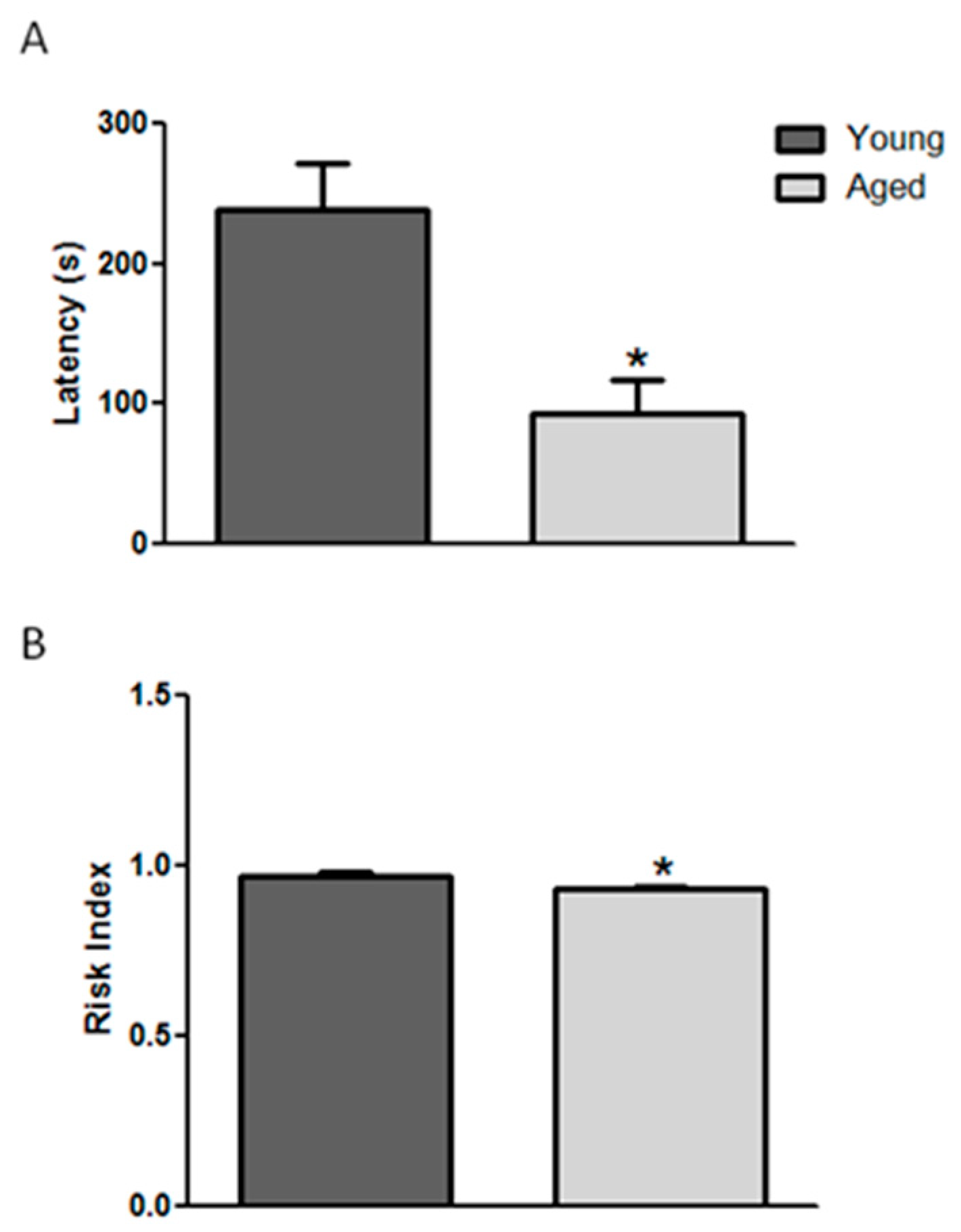
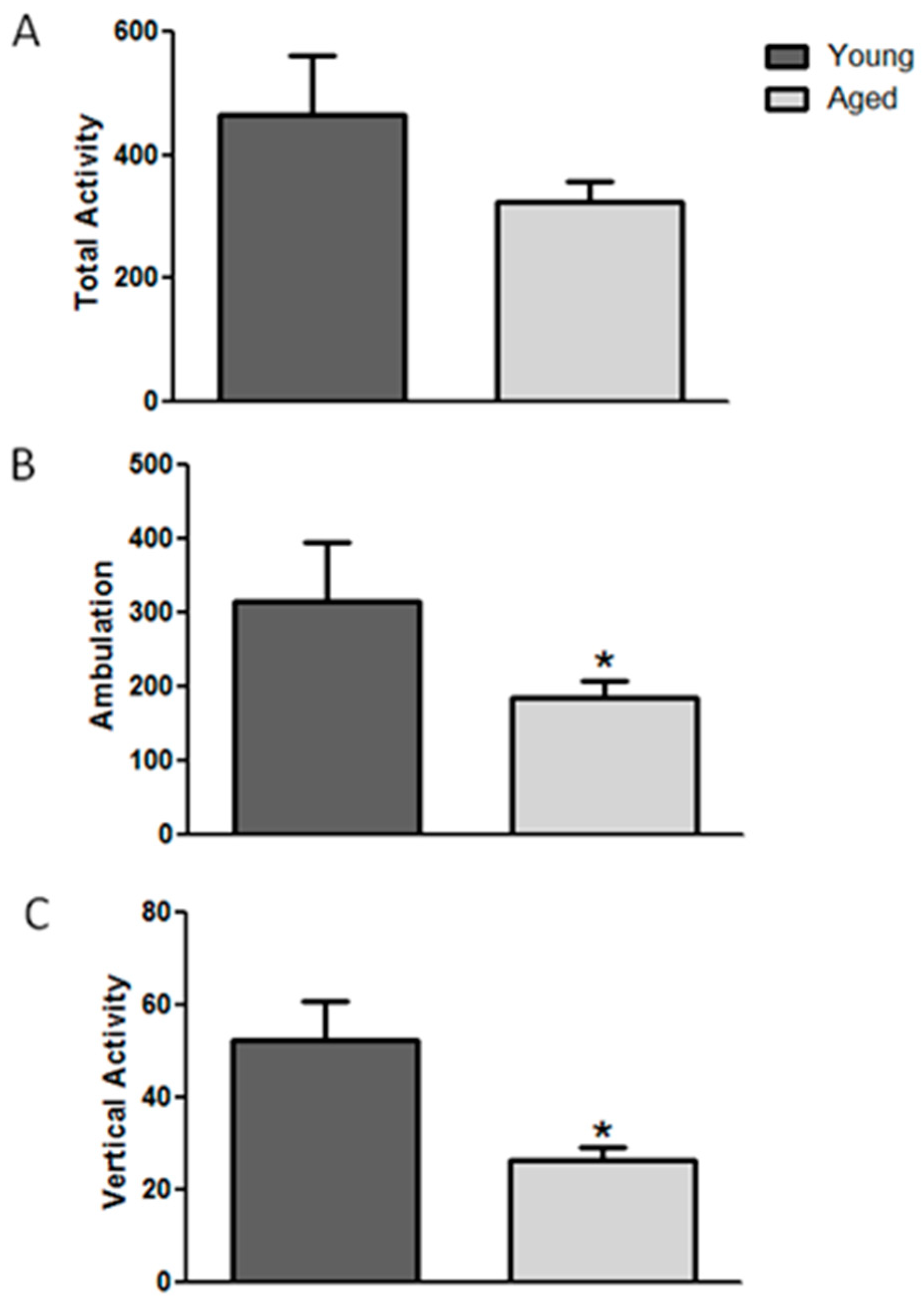
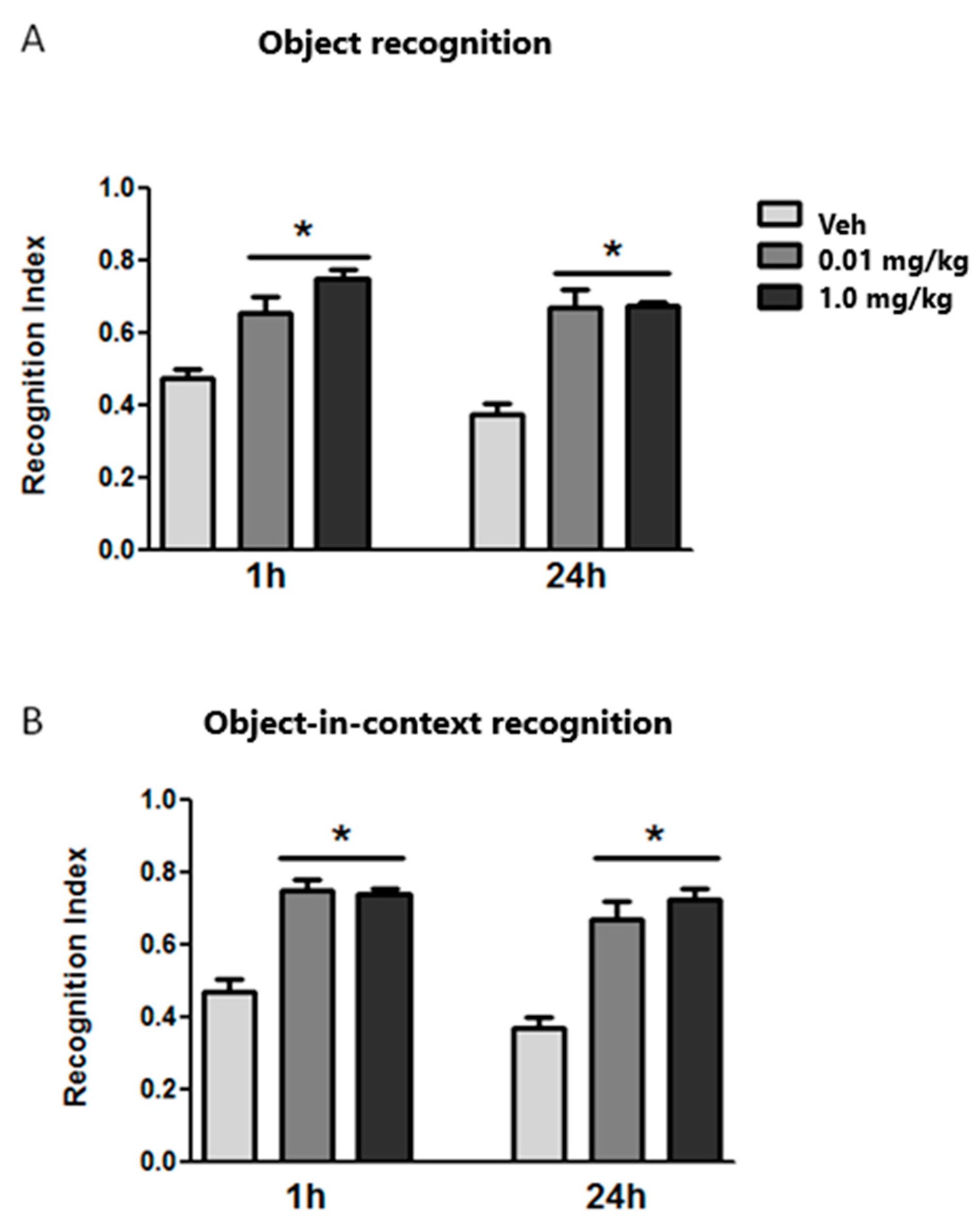
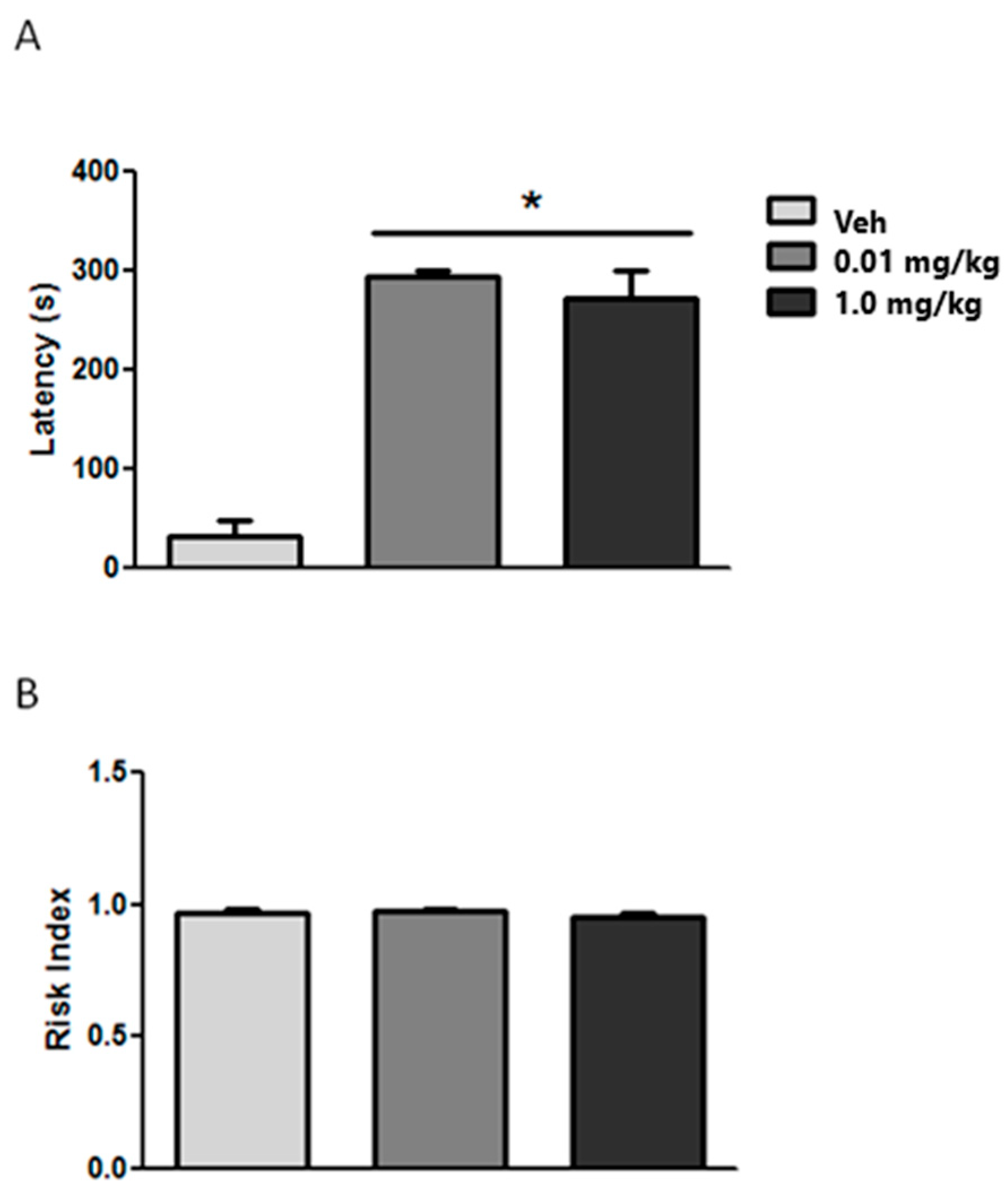
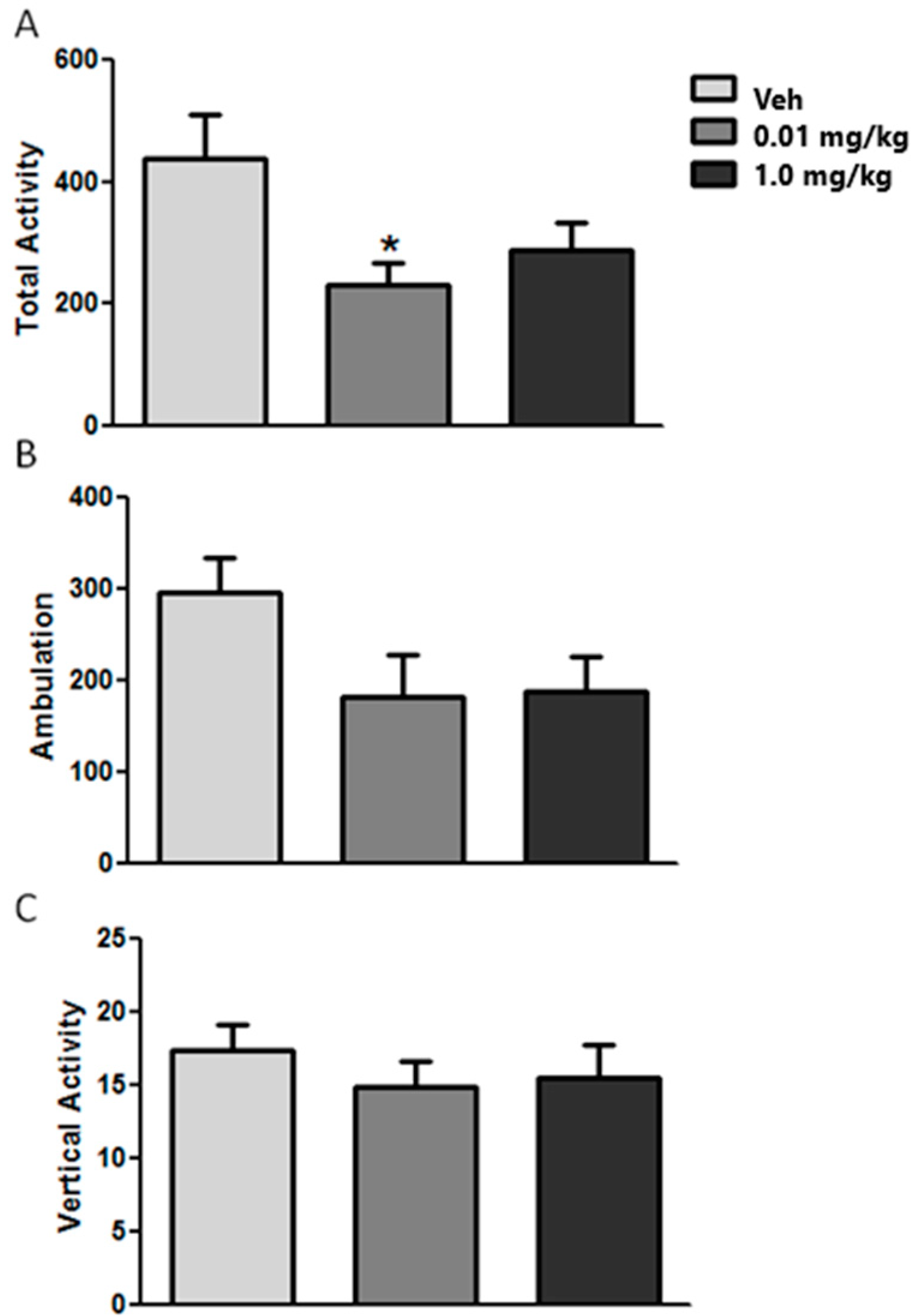


Disclaimer/Publisher’s Note: The statements, opinions and data contained in all publications are solely those of the individual author(s) and contributor(s) and not of MDPI and/or the editor(s). MDPI and/or the editor(s) disclaim responsibility for any injury to people or property resulting from any ideas, methods, instructions or products referred to in the content. |
© 2024 by the authors. Licensee MDPI, Basel, Switzerland. This article is an open access article distributed under the terms and conditions of the Creative Commons Attribution (CC BY) license (https://creativecommons.org/licenses/by/4.0/).
Share and Cite
Castillo-Mendieta, T.; Bautista-Poblet, G.; Coyoy-Salgado, A.; Castillo-García, E.L.; Pinto-Almazán, R.; Fuentes-Venado, C.; Neri-Gómez, T.; Guerra-Araiza, C. Effect of Chronic Tibolone Administration on Memory and Choline Acetyltransferase and Tryptophan Hydroxylase Content in Aging Mice. Brain Sci. 2024, 14, 903. https://doi.org/10.3390/brainsci14090903
Castillo-Mendieta T, Bautista-Poblet G, Coyoy-Salgado A, Castillo-García EL, Pinto-Almazán R, Fuentes-Venado C, Neri-Gómez T, Guerra-Araiza C. Effect of Chronic Tibolone Administration on Memory and Choline Acetyltransferase and Tryptophan Hydroxylase Content in Aging Mice. Brain Sciences. 2024; 14(9):903. https://doi.org/10.3390/brainsci14090903
Chicago/Turabian StyleCastillo-Mendieta, Tzayaka, Guadalupe Bautista-Poblet, Angélica Coyoy-Salgado, Emily L. Castillo-García, Rodolfo Pinto-Almazán, Claudia Fuentes-Venado, Teresa Neri-Gómez, and Christian Guerra-Araiza. 2024. "Effect of Chronic Tibolone Administration on Memory and Choline Acetyltransferase and Tryptophan Hydroxylase Content in Aging Mice" Brain Sciences 14, no. 9: 903. https://doi.org/10.3390/brainsci14090903





